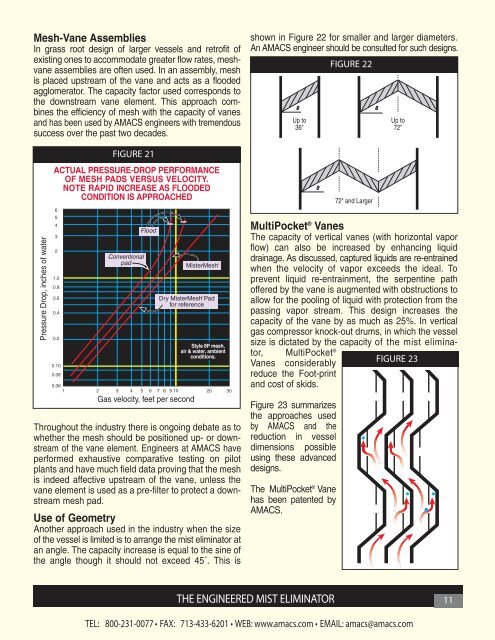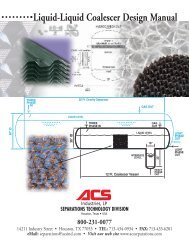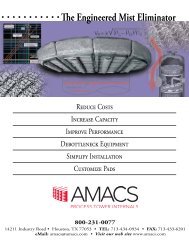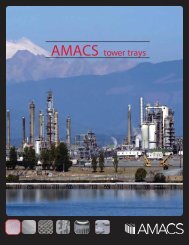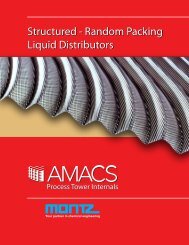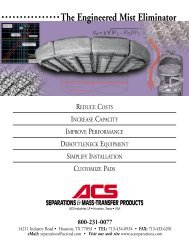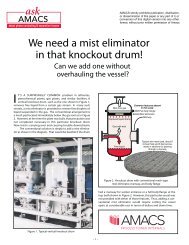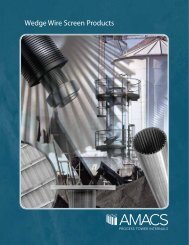Mesh and Vane Mist Eliminator Brochure - AMACS Process Tower ...
Mesh and Vane Mist Eliminator Brochure - AMACS Process Tower ...
Mesh and Vane Mist Eliminator Brochure - AMACS Process Tower ...
You also want an ePaper? Increase the reach of your titles
YUMPU automatically turns print PDFs into web optimized ePapers that Google loves.
<strong>Mesh</strong>-<strong>Vane</strong> Assemblies<br />
In grass root design of larger vessels <strong>and</strong> retrofit of<br />
existing ones to accommodate greater flow rates, meshvane<br />
assemblies are often used. In an assembly, mesh<br />
is placed upstream of the vane <strong>and</strong> acts as a flooded<br />
agglomerator. The capacity factor used corresponds to<br />
the downstream vane element. This approach combines<br />
the efficiency of mesh with the capacity of vanes<br />
<strong>and</strong> has been used by <strong>AMACS</strong> engineers with tremendous<br />
success over the past two decades.<br />
shown in Figure 22 for smaller <strong>and</strong> larger diameters.<br />
An <strong>AMACS</strong> engineer should be consulted for such designs.<br />
FIGURE 22<br />
FIGURE 21<br />
ACTUAL PRESSURE-DROP PERFORMANCE<br />
OF MESH PADS VERSUS VELOCITY.<br />
NOTE RAPID INCREASE AS FLOODED<br />
CONDITION IS APPROACHED<br />
MultiPocket ® <strong>Vane</strong>s<br />
The capacity of vertical vanes (with horizontal vapor<br />
flow) can also be increased by enhancing liquid<br />
drainage. As discussed, captured liquids are re-entrained<br />
when the velocity of vapor exceeds the ideal. To<br />
prevent liquid re-entrainment, the serpentine path<br />
offered by the vane is augmented with obstructions to<br />
allow for the pooling of liquid with protection from the<br />
passing vapor stream. This design increases the<br />
capacity of the vane by as much as 25%. In vertical<br />
gas compressor knock-out drums, in which the vessel<br />
size is dictated by the capacity of the mist eliminator,<br />
MultiPocket ®<br />
<strong>Vane</strong>s considerably<br />
FIGURE 23<br />
reduce the Foot-print<br />
<strong>and</strong> cost of skids.<br />
Throughout the industry there is ongoing debate as to<br />
whether the mesh should be positioned up- or downstream<br />
of the vane element. Engineers at <strong>AMACS</strong> have<br />
performed exhaustive comparative testing on pilot<br />
plants <strong>and</strong> have much field data proving that the mesh<br />
is indeed affective upstream of the vane, unless the<br />
vane element is used as a pre-filter to protect a downstream<br />
mesh pad.<br />
Use of Geometry<br />
Another approach used in the industry when the size<br />
of the vessel is limited is to arrange the mist eliminator at<br />
an angle. The capacity increase is equal to the sine of<br />
the angle though it should not exceed 45˚. This is<br />
Figure 23 summarizes<br />
the approaches used<br />
by <strong>AMACS</strong> <strong>and</strong> the<br />
reduction in vessel<br />
dimensions possible<br />
using these advanced<br />
designs.<br />
The MultiPocket ® <strong>Vane</strong><br />
has been patented by<br />
<strong>AMACS</strong>.<br />
THE ENGINEERED MIST ELIMINATOR 11<br />
TEL:<br />
800-231-0077 • FAX: 713-433-6201 • WEB: www.amacs.com • EMAIL: amacs@amacs.com


